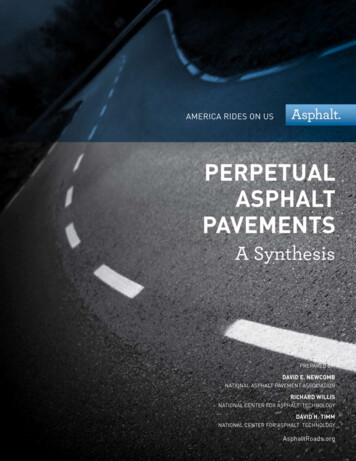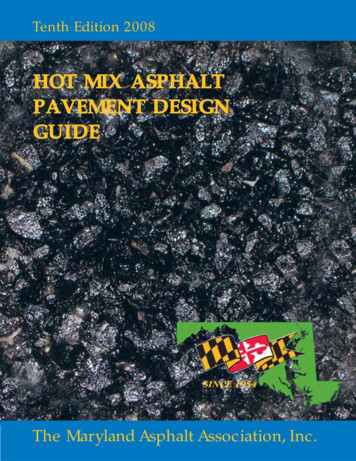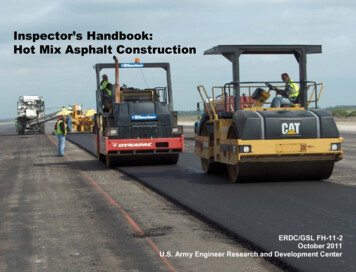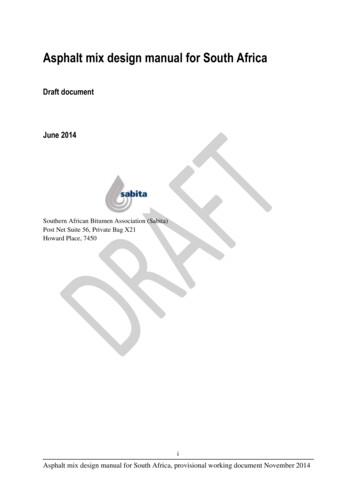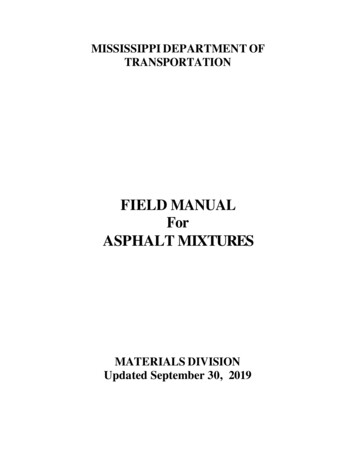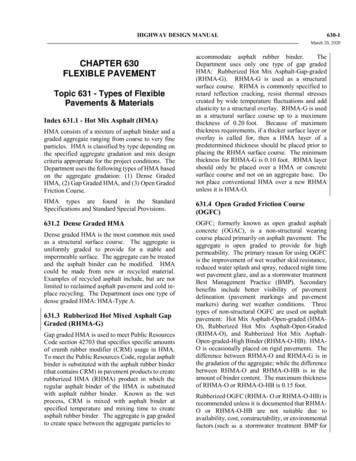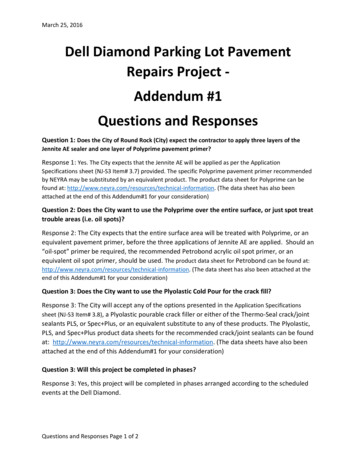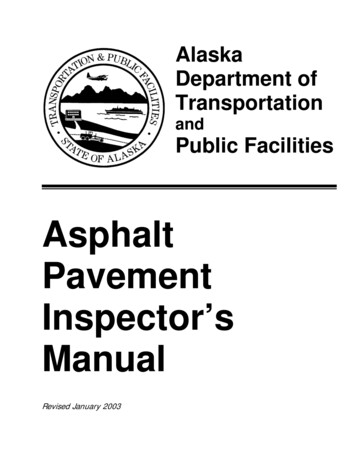
Transcription
AlaskaDepartment ofTransportationandPublic d January 2003
Asphalt PavementInspector’s ManualRevised January 2003
ForewordThe information currently available on asphalt paving would fill a small library. Furthermore, DOT&PF’s AlaskaConstruction Manual describes procedures for the Department's staff to use on all aspects of construction projects.This manual draws on the Alaska Construction Manual and other sources but does not attempt to replace them asa reference for official Department policy. It is intended to present portions of this information needed bylaydown and asphalt plant inspectors in a convenient form. It also presents information of value to pavingmaterials inspectors. Material test procedures are so detailed, however, and test requirements so variable betweenprojects, that this manual presents only rather general information about them.More information on asphalt and paving is available in the publications listed in Appendix F (Further Reading).Many of these are available at your construction project office or the regional Materials office. A copy of theAlaska Construction Manual should also be at the project office.The Alaska Transportation Technology Transfer Center can provide a wealth of videotapes and publicationsdealing with paving and other transportation issues. Their address and phone number are listed in Appendix F.Many individuals and agencies assisted in the preparation of this manual by reviewing draft versions and bymaking photographs and figures available. Ed Schlect of the Asphalt Institute is notable in this regard. NicoleGreene and Sheree Warner spent many hours preparing the text for publication. The authors appreciate andacknowledge this help.Asphalt Pavement Inspector’s ManualiForewordEffective November 2002
The third revision of this manual was accomplishedwith the help of: Myles A. Comeau, Paving Inspector forNorthern Region, who reviewed themanual for changes and recommendations R. Scott Gartin, Statewide Materials,Pavement Management Engineer, whoprovided his paper on Pavement andSurface Treatments used in Maintenance,Rehabilitation, and Construction John S. Ball, III, whose article Like Nightand Day appears courtesy of The AsphaltContractor Gary L. Eddy, P.E., State ConstructionStandards Engineer, who reformatted,made corrections, printed, and placed themanual on the DOT&PF Design &Construction Standards Home PageForewordEffective November 20022Asphalt Pavement Inspector’s Manual
Table of Contents1.Background. 1-11.1.1.2.1.3.Hot Asphalt Concrete Paving: A Brief Description . 1-1Airport, Highway, and Marine Facility Pavements. 1-2Safety. 1-21.3.1Safety Equipment Checklist.1-21.3.2Safety on the Paving Project .1-21.3.3Documenting Accidents.1-51.4. Plans and Specifications. 1-51.4.1Airport Projects.1-61.4.2Highway Projects .1-61.5. Traffic Control . 1-61.5.1Air Traffic Control .1-61.5.2Air Traffic Control Checklist.1-61.5.3Avoiding Accidents.1-61.5.4Highway Traffic Control .1-71.5.5Highway Traffic Control Checklist .1-72.General Guidelines for the Inspector . 2-12.1.2.2.2.3.2.4.2.5.2.6.3.Introduction .Asphalt Paving Inspection.General Responsibilities of the Inspector.Record Keeping.Authority of the Inspector .Relationship with the Contractor.2-12-12-22-22-22-3Materials . 3-13.1.Responsibilities of the Materials Inspector . 3-13.1.1Materials Testing Requirements.3-13.1.2Test Categories.3-13.1.3Testing Procedures.3-23.1.4When to Test.3-23.2. Brief Description of Tests . 3-23.2.1Acceptance Testing.3-23.2.2Quality Requirements and Documentation .3-73.2.3Check Marshall Tests.3-73.2.4Materials Handling .3-83.3Marshall Mix Design: An Overview . 3-83.3.1Marshall Method.3-93.3.2The Mix Design Report .3-93.4. The 0.45 Power Chart. 3-104.Asphalt Plant. 4-14.1.4.2.4.3.Introduction . 4-1Dryer Drum-Mix Plants . 4-2Proper Plant Operation . 4-54.3.1General.4-5Asphalt Pavement Inspector’s ManualiTable of ContentsRevised January 2003
114.3.124.3.134.3.145.Surface Preparation (Prime and Tack Coats). 5-15.1.5.2.5.3.5.4.5.5.6.Stockpiling.4-5Cold Bins.4-5Cold Feed .4-5Asphalt Cement Storage .4-6Batch Plant Dryer .4-6Drum-Mixer Dryer .4-7Dust Collector .4-7Hot Mix Storage and Loading.4-7Screening Unit.4-7Hot Bins.4-10Weigh Box .4-10Asphalt Weigh Bucket.4-10Pugmill .4-10Preparing Existing Pavement (Tack Coat) . 5-15.1.1Leveling .5-15.1.2Surface Preparation for Tack Coat .5-15.1.3Tack Coat .5-2Preparing an Aggregate Surface (Prime Coat) . 5-35.2.1Alignment, Grade, and Compaction.5-35.2.2Surface Preparation for Prime Coat .5-35.2.3Prime Coat .5-45.2.4Blotter Material.5-45.2.5Emulsified Asphalt Treated Base .5-5Distributor Truck. 5-6Responsibilities of the Inspector . 5-7Prime and Tack Logs. 5-11Laydown. 6-16.1.6.2.6.3.6.4.6.5.6.6.6.7.Responsibilities and Authority of the Laydown Inspector . 6-16.1.1Areas of Responsibility.6-16.1.2Records.6-26.1.3Laydown Inspector’s Checklists.6-2Equipment . 6-36.2.1Hauling Units (Trucks).6-36.2.2Pavers.6-46.2.3Pickup Machines .6-86.2.4Rollers .6-8Placement . 6-106.3.1Hand Raking.6-11Joints . 6-116.4.1Transverse Joints .6-116.4.2Longitudinal Joints.6-12Compaction . 6-13Spread Calculations and Control. 6-186.6.1Spread and Yield Ratio Calculations .6-186.6.2Adjusting the Spread .6-19Inspecting the Finished Mat . 6-19Table of ContentsRevised January 2003iiAsphalt Pavement Inspector’s Manual
7.Open-Graded and Recycled Asphalt Concretes . 7-17.1.Open-Graded and Asphalt Concrete . 7-17.1.1Construction Methods .7-17.2. Recycled Asphalt Pavements . 7-17.2.1Reclaimed Asphalt Pavement (RAP) .7-17.2.2Hot Asphalt Recycling.7-17.2.3Cold-Mix Recycling.7-28.Appendix A: Troubleshooting Guide . .12.9.Appendix B: Asphalt Material Temperature/Volume Corrections(English Units) . 9-19.1.9.2.9.39.4.10.Hot-Mix Asphalt Pavements . 8-18.1.1Preface .8-1Possible Causes of Deficiencies in Plant-Mix Pavements .
The information currently available on asphalt paving would fill a small library. Furthermore, DOT&PF’s Alaska Construction Manual describes procedures for the Department's staff to use on all aspects of construction projects. This manual draws on the Alaska Construction Manual and other sources but does not attempt to replace them as a reference for official Department policy. It is .

